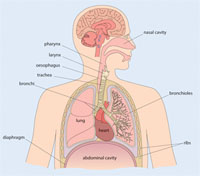35.1 What are acute respiratory tract infections?
Acute respiratory tract infections (ARIs) are bacterial or viral infections of the respiratory tract leading to breathing difficulties, fever and other complications, including infections in the ear and the membranes surrounding the brain. ARIs are classified according to whether they affect the upper or lower respiratory tracts (Figure 35.2). The upper respiratory tract consists of the airways from the nostrils to the vocal cords in the larynx (voice box), and includes the pharynx (back of the throat) and part of the internal structure of the ear (the middle ear). The lower respiratory tract refers to the continuation of the airways below the larynx and the branching airways throughout the lungs.

Upper respiratory tract infections (URIs) are the most common of all communicable diseases. They are transmitted from one person to another by airborne droplets spread through coughing or sneezing. URIs include mild self-limiting infections such as the common cold (rhinitis), and more severe acute infections in the ear (acute otitis media), or in the pharynx (pharyngitis). Lower respiratory tract infections (LRIs) are the leading cause of pneumonia, which will be described in Section 35.4 of this study session. First, we discuss acute otitis media and then pharyngitis, both of which can cause severe complications in children.
Rhinitis is pronounced ‘riy-niy-tiss’; otitis is pronounced ‘oh-tiy-tiss’; pharyngitis is pronounced ‘fah-rin-jiy-tiss’.
Learning Outcomes for Study Session 35
